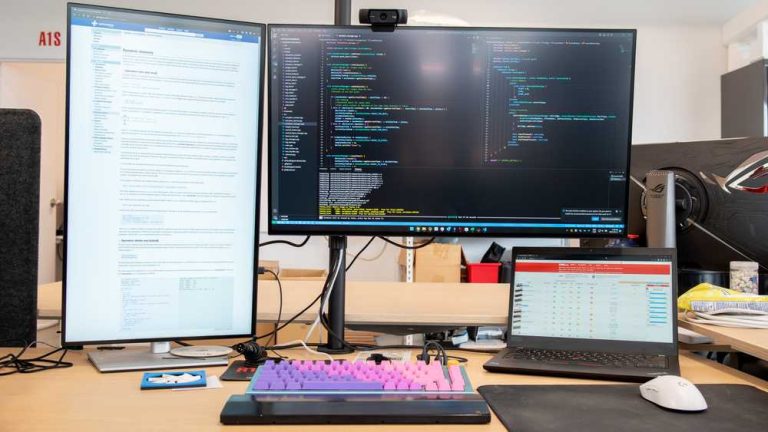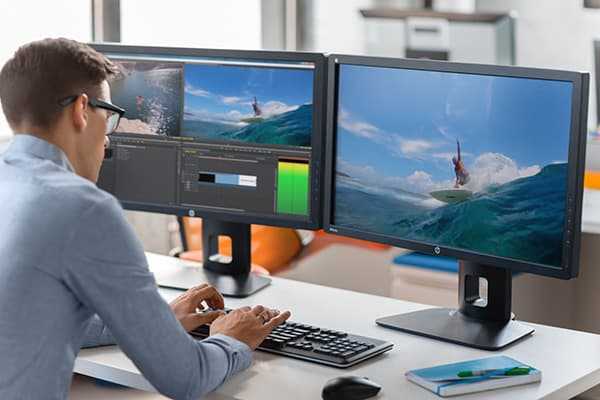Using dual screens can boost your productivity, but what about gaming? Does running two monitors slow down your gaming experience? The quick answer is that it can, but it depends on your hardware and how you set up your system. While some gamers might notice a slight drop in performance, others may not see any difference at all, especially if their PC is built to handle multiple displays.
Dual screens can introduce some additional strain on your GPU, which might impact frame rates or cause stuttering during gameplay. However, with a powerful graphics card and proper configuration, you can enjoy the benefits of multiple screens without sacrificing much in your gaming performance. Keep reading to learn how dual monitors affect your gaming and tips to minimize any potential performance issues.
Gaming on multiple screens offers an immersive experience, but it also raises concerns about performance hiccups. If you’re considering adding a second monitor to your setup, you might wonder if it will hinder your gaming performance or cause lag. The truth is, running dual screens can affect your gaming experience somewhat, especially if your system isn’t optimized or equipped with high-end hardware. The extra workload on your GPU means it needs to render more pixels and manage more data, which can reduce frame rates or cause stuttering. However, with a robust graphics card and proper settings, many gamers find that the impact is minimal. Understanding how dual monitors interact with your system can help you enjoy a seamless gaming session while benefiting from the productivity and multitasking advantages of multiple screens.
Does Dual Screen Affect Gaming Performance?
Introduction to Dual Screens and Gaming
Using two screens while gaming is becoming more common among players. Many gamers believe it helps improve their gameplay, while others worry it might cause issues. Understanding how dual screens impact game performance is essential for making the right setup choice.
How Dual Screens Interact with Gaming Hardware
Dual monitors demand more from your computer. They require a powerful graphics card that can handle rendering on two screens at once. If your hardware isn’t strong enough, gaming performance can slow down.
Graphics Card Requirements
A high-quality graphics card is key to smooth gameplay on dual screens. Cards like NVIDIA GeForce RTX series or AMD Radeon RX series are popular choices. These cards can manage multiple displays without sacrificing game performance.
System RAM and Processor Impact
Apart from the graphics card, your CPU and RAM also influence gaming performance. More RAM helps manage background processes and multitasking, ensuring your game runs smoothly across two screens.
Potential Performance Issues with Dual Monitors
While dual screens can enhance gaming, they also introduce potential problems. These include decreased frame rates, increased input lag, and higher system load.
Frame Rate Dropping
Running games across two screens may cause a drop in frame rates, especially if your system isn’t equipped for it. Lower frame rates can lead to choppy visuals, making gameplay less enjoyable.
Input Lag and Responsiveness
Dual monitors can sometimes add slight delays between action and on-screen response. This input lag can be problematic in fast-paced games where quick reactions matter most.
System Load and Overheating
Using two displays puts extra load on your GPU and CPU, which could lead to overheating if your cooling system isn’t adequate. It’s important to keep hardware well-maintained to prevent performance drops.
Optimizing Gaming Performance on Dual Screens
Fortunately, there are ways to reduce the impact of dual monitors on gaming. Proper setup and settings adjustments can improve performance significantly.
Adjusting Display Settings
Set your game resolution to match your primary monitor to prevent unnecessary rendering. Use the lowest acceptable graphics settings for secondary screens to lessen GPU load.
Updating Drivers and Software
Make sure your graphics card drivers are up-to-date. Updated drivers often include improvements for dual monitor configurations and gaming performance.
Using Game Mode and Performance Tools
Activate Windows Game Mode or similar software to prioritize gaming tasks. Some graphics cards also have software features to optimize performance across multiple displays.
Impact of Different Types of Games
Not all games react the same to dual monitors. The game genre influences how much dual screens affect performance.
First-Person Shooters (FPS)
FPS games often demand high frame rates and quick reactions. Dual screens can cause slight performance drops but may offer advantages like a wider field of view.
Real-Time Strategy (RTS) and Simulation Games
RTS and simulation games benefit from extra screen space for managing multiple units and resources. Performance impact is usually minimal if hardware is adequate.
MMORPGs and Open-World Games
Massively multiplayer online role-playing games may experience more noticeable performance issues on dual screens due to large environments and high graphic detail.
Benefits of Dual Screens in Gaming
Despite potential drawbacks, dual screens offer several benefits that can enhance your gaming experience.
Improved Multitasking
Play your game on one screen while using the other for chats, guides, or streaming controls. This setup improves multitasking without interrupting gameplay.
Enhanced Game Strategy
In strategy and simulation games, dual monitors provide more space to view different parts of the game world simultaneously, helping with better decision-making.
Streaming and Content Creation
Dual screens are ideal for streamers who want to monitor chats or control streaming software while gaming, leading to a more seamless streaming experience.
Dual Screen Setup Tips for Gamers
Proper setup is critical to minimize the downsides of dual monitors for gaming.
Positioning Your Monitors
Place your primary monitor directly in front of you at eye level. Keep the secondary monitor close and at a comfortable angle for easy viewing.
Matching Monitor Specs
Use monitors with similar resolution, refresh rate, and size to ensure consistency and avoid visual discrepancies during gameplay.
Ensuring Adequate Hardware
Invest in a robust graphics card and sufficient RAM. Regular maintenance, such as cleaning hardware and updating drivers, helps sustain performance.
Related Topics and Considerations
There are other factors that influence gaming performance on dual screens.
Monitor Refresh Rate and Response Time
Higher refresh rates (above 60Hz) provide smoother visuals, especially important in fast-paced entries. Low response times reduce ghosting and input lag.
Display Resolution and Aspect Ratio
Matching resolutions across monitors helps prevent visual stretching and performance issues. An ultra-wide aspect ratio offers an immersive experience without dual screen setups.
Connectivity and Cables
Use high-quality HDMI or DisplayPort cables to ensure stable connections. Incorrect or loose connections may cause flickering or signal loss during gaming.
Virtual Desktop and Window Management
Use software solutions to manage how games utilize multiple screens. Settings that span games smoothly across displays improve overall experience.
Summary of Dual Screen Impact on Gaming Performance
In summary, dual screens can influence gaming performance based on hardware, game type, and setup. While they can lead to reduced frame rates or input lag if hardware isn’t suitable, proper adjustments can minimize these effects. Benefits like multitasking and an expanded view often outweigh the drawbacks for many gamers.
By choosing the right hardware, configuring settings correctly, and understanding the demands of your favorite games, you can get the best out of a dual monitor setup. With these tips, you’ll be able to enjoy an enhanced gaming experience without sacrificing performance.
Frequently Asked Questions
How does running multiple screens impact system resources during gaming?
Using dual screens can increase the demand on your system’s CPU and GPU, especially if both displays are active during gameplay. This additional load can lead to reduced frame rates or increased lag if your hardware isn’t sufficiently powerful. To mitigate this, ensure your system meets the recommended specifications for your games and consider adjusting settings like resolution and graphics quality when using dual monitors.
Can the size or resolution of a second monitor affect game performance?
Yes, larger or higher-resolution secondary monitors require more graphical processing power, which can impact overall game performance. When the GPU struggles to render high-resolution content on both screens simultaneously, you may experience lower frame rates or stuttering. Opting for a lower resolution on the secondary monitor or adjusting in-game settings can help maintain smoother gameplay.
Does enabling features like G-Sync or FreeSync influence the performance of gaming on dual screens?
Enabling adaptive sync technologies like G-Sync or FreeSync improves visual fluidity on compatible monitors by reducing screen tearing and stuttering. However, these features can also add slightly to the GPU’s workload, especially if you run both displays at high refresh rates or resolutions. While the performance impact is usually minimal on modern hardware, it’s wise to test your setup to ensure smooth gameplay.
Is there a significant difference in gameplay performance when using a dedicated graphics card versus integrated graphics with dual monitors?
Using a dedicated graphics card generally provides better performance for gaming with dual monitors, as it handles rendering tasks more efficiently than integrated graphics. Integrated solutions may struggle with high-resolution displays or demanding games, leading to decreased frame rates and longer load times. For optimal performance, a dedicated GPU is recommended when gaming on multiple screens.
Can background applications on the second monitor affect gaming performance?
Yes, applications running on the second monitor, such as streaming tools, chat programs, or web browsers, can consume system resources like CPU and RAM, which might impact gaming performance. To maintain smooth gameplay, close unnecessary applications or prioritize game processes through your system management tools.
Final Thoughts
Using dual screens can enhance multitasking and create an immersive gaming experience. However, it may slightly impact performance due to increased GPU load.
Modern hardware generally handles dual screens well, but lower-end systems might experience minor frame drops. This effect varies based on your graphics card and game settings.
In conclusion, does dual screen affect gaming performance? It can, but the impact depends on your hardware. With capable equipment, dual monitors won’t significantly hinder your gaming experience.
I’m passionate about hardware, especially laptops, monitors, and home office gear. I share reviews and practical advice to help readers choose the right devices and get the best performance.




